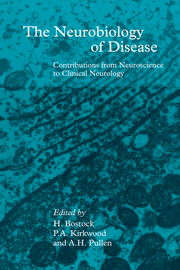Book contents
- Frontmatter
- Contents
- List of contributors
- Preface
- Part I Physiology and pathophysiology of nerve fibres
- Part II Pain
- 13 Human nociceptors in health and disease
- 14 Sensory consequences of inflammation
- 15 Non-voluntary muscle activity and myofascial pain syndromes
- 16 Is there a mechanism for the spinal cord to remember pain?
- 17 The neurophysiological basis of pain relief by acupuncture
- Part III Control of central nervous system output
- Part IV Development, survival, regeneration and death
- Index
13 - Human nociceptors in health and disease
from Part II - Pain
Published online by Cambridge University Press: 04 August 2010
- Frontmatter
- Contents
- List of contributors
- Preface
- Part I Physiology and pathophysiology of nerve fibres
- Part II Pain
- 13 Human nociceptors in health and disease
- 14 Sensory consequences of inflammation
- 15 Non-voluntary muscle activity and myofascial pain syndromes
- 16 Is there a mechanism for the spinal cord to remember pain?
- 17 The neurophysiological basis of pain relief by acupuncture
- Part III Control of central nervous system output
- Part IV Development, survival, regeneration and death
- Index
Summary
Introduction
In the mid 1960s, a rare collection of normal human peripheral nerves obtained from healthy volunteers came from Chile to the Institute of Neurology in London. The material awaited further examination and quantitation by electron microscopy, which was eventually accomplished under the direction and unfailing support of W.G.P. Mair (Ochoa & Mair, 1969a, b). At that time, all we had at hand were reproductions of human unmyelinated fibres originally drawn by Remak, and micrographs of silver stains of unmyelinated axons obtained by Ranson and later by Gasser. We learned that, in man, unmyelinated fibres exhibit a specific fine structure and are 4 times more abundant than myelinated fibres. Unmyelinated fibres drop out with age and in disease. Under those circumstances the surviving axons produce tiny sprouts which make their calibre spectrum bimodal.
Basic electrophysiology
Zotterman, the impetuous Swedish scientist who first recorded impulse activity in unmyelinated (C) fibres in animals, often credited Hallin and Torebjörk with being the pioneer investigators who first recorded propagated impulse activity in C-fibres in humans (Hallin & Torebjörk, 1970; Torebjörk & Hallin, 1970). The equally outstanding work from Belgium, by Van Hees & Gybels (1972), came at about the same time. Through the use of the microneurographic technique of Hagbarth and Vallbo (Hagbarth & Vallbo 1967; Vallbo & Hagbarth, 1968), Swedes and Belgians managed to obtain single-unit recordings of C-fibre activity from undissected nerves of awake human subjects, and described receptor–response properties of C polymodal nociceptors supplying human skin.
- Type
- Chapter
- Information
- The Neurobiology of DiseaseContributions from Neuroscience to Clinical Neurology, pp. 151 - 161Publisher: Cambridge University PressPrint publication year: 1996

